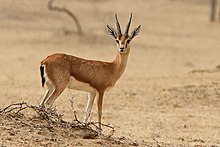Chinkara
| Chinkara | |
|---|---|

| |
| Chinkara from Thar Desert, Rajasthan, India | |
| Scientific classification | |
| Domain: | Eukaryota |
| Kingdom: | Animalia |
| Phylum: | Chordata |
| Class: | Mammalia |
| Order: | Artiodactyla |
| Family: | Bovidae |
| Subfamily: | Antilopinae |
| Tribe: | Antilopini |
| Genus: | Gazella |
| Species: | G. bennettii[1]
|
| Binomial name | |
| Gazella bennettii[1] (Sykes, 1831)
| |

| |
| Distribution map of chinkara | |
The chinkara (Gazella bennettii), also known as the Indian gazelle, is a gazelle species native to India, Iran, Afghanistan and Pakistan.[2]
Taxonomy
The following six subspecies are considered valid:[1]
- Ganges Valley (east to the borders of West Bengal) south at least to Hyderabad, Andhra Pradesh, Deccan Plateau;
- Gujarat chinkara (G. b. christii) (Blyth, 1842) – ranges from the desert lowlands of Pakistan, western India, Rann of Kutch, Kathiawar, Saurastra region and as far east of Ahmedabad district in Gujarat;
- Sistan and Baluchistan) southern Afghanistan, Pakistan, Balochistan Province to Sindh and northwestern India, Rajasthan, also the darkest subspecies;
- Bushehr gazelle (G. b. karamii) (Groves, 1993) – ranges in northeastern Iran, restricted near Bushehr, also the smallest subspecies;[3]
- Tehran and southwest to Shiraz County and beyond), also the palest subspecies;[3]
- Salt Range gazelle (G. b. salinarum) (Groves, 2003) – ranges in Pakistan, Punjab region and east as far as Delhi, Indian Punjab, Haryana in northwest India, salt range;[4]
Characteristics

It stands at 65 cm (26 in) tall and weighs about 23 kg (51 lb). It has a reddish-buff summer coat with smooth, glossy fur. In winter, the white belly and throat fur is in greater contrast. The sides of the face have dark chestnut stripes from the corner of the eye to the muzzle, bordered by white stripes. Its horns reach over 39 cm (15 in).[5]
Distribution and habitat
Chinkara live in arid plains and hills, deserts, dry scrub and light forests. They inhabit more than 80 protected areas in India. In Pakistan, they range up to elevations of 1,500 m (4,900 ft). In Iran, their largest population is the Kavir National Park.[6]
In 2001, the Indian chinkara population was estimated at 100,000 with 80,000 living in the Thar Desert. The population in Pakistan is scattered, and has been severely reduced by hunting. Also in Iran, the population is fragmented. In Afghanistan, chinkaras are probably very rare.[6]
Ecology

Chinkaras are shy and avoid human habitation. They can go without water for long periods and can get sufficient fluids from plants and dew droplets that get deposited on the plant surface in the night. Although most are seen alone, they can sometimes be spotted in groups of up to four animals.[citation needed]

Chinkaras are preyed upon by
Conservation
The chinkara occurs in over 80 protected areas in India.[8] In January 2016, the Karnataka government issued a notification to establish a sanctuary especially for chinkara in the Yadahalli village in the Bagalkot district of the state. This region shelters a major population of chinkara.[9] The Karnataka Government also notified the Bukkapatna Chinkara Wildlife Sanctuary in Tumakuru district in May 2019.[10] The chinkara is protected in that's distribution areas of Iran and five of Pakistan.[2]
Threats
The chinkara is threatened by extensive hunting for meat and
In 1993, a controversy erupted when the
See also
References
- ^ OCLC 62265494.
- ^ . Retrieved 19 November 2021.
- ^ ISBN 9782831705941. Retrieved 17 December 2016.
- ISBN 9781421400938. Retrieved 17 December 2016.
- ^ Prater, S. H. (1971). The Book of Indian Animals. Oxford University Press, 2005 reprint.
- ^ a b Mallon, D. P. and S. C. Kingswood (eds.) (2001). Antelopes. Part 4: North Africa, the Middle East, and Asia. Global Survey and Regional Action Plans, IUCN, Gland, Switzerland.
- ^ McCart, Dylan. "Gazella bennettii-Indian Gazelle". Animal Diversity Web. Retrieved 25 June 2019.
- ^ ISBN 9782831705941.
- ^ Prabhu, N. (2016). "State gets first chinkara sanctuary". The Hindu. Retrieved 12 March 2016.
- ^ "Chinkara sanctuary: Karnataka: Chinkara sanctuary at Tumakuru notified | Bengaluru News - Times of India". The Times of India. 17 May 2019.
- ^ Kumar, S. (1995). "Mining digs deep into India's wildlife refuges". New Scientist. Retrieved 12 March 2016.

